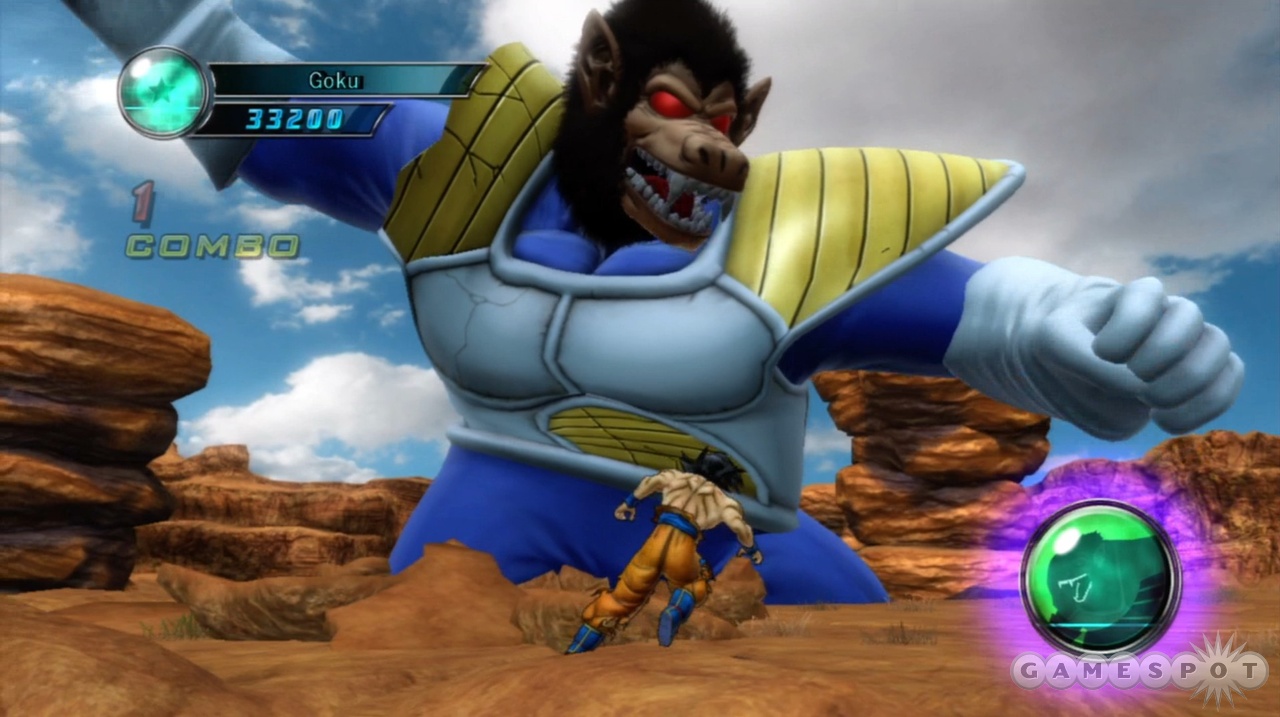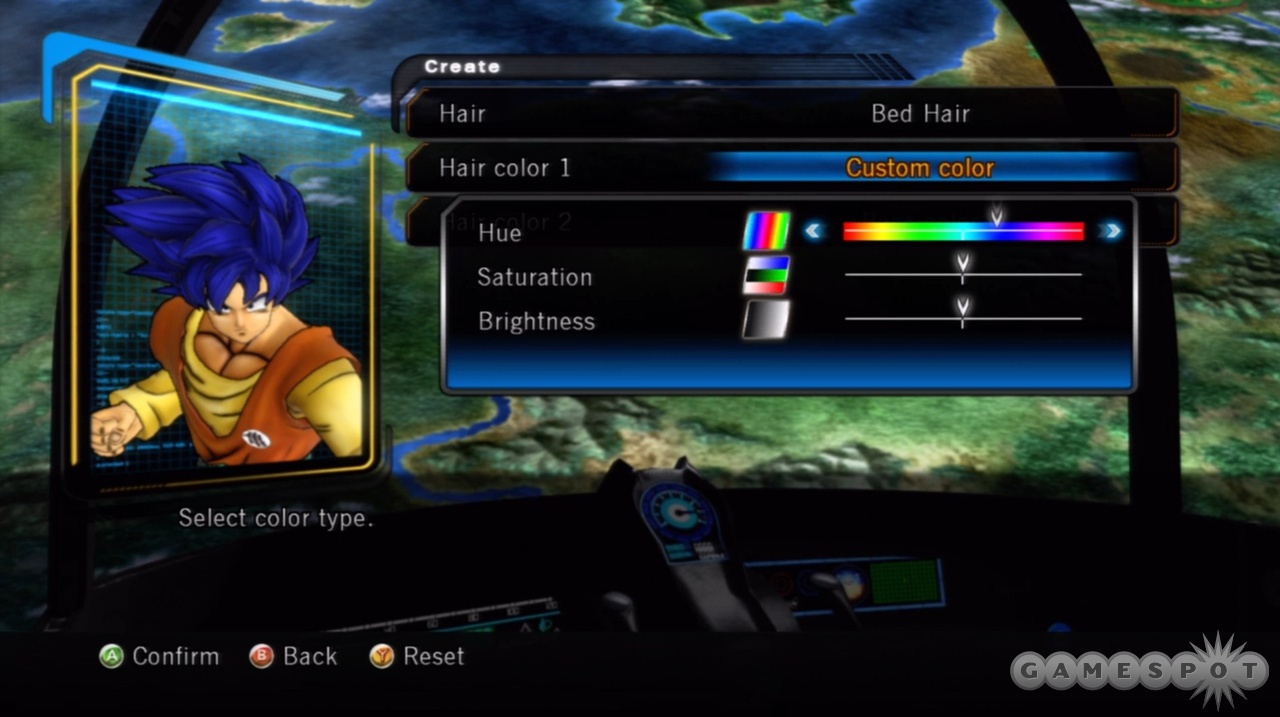No ordinary human could ever perform the kinds of tremendously devastating and destructive attacks that the characters of the Dragon Ball Z universe regularly pull off. But even for Goku, Vegeta, Piccolo, and the rest of the gang, such abilities take dedication, training, and a great deal of energy and effort. In Dragon Ball Z: Ultimate Tenkaichi, however, sending opponents flying through the air with a kick is as easy as pushing a button, and firing off a kamehameha takes only a press of the right thumbstick. In fact, combat requires so little effort on your part that, despite the explosive display of power and fighting skill happening onscreen, it's hard to feel invested in what's taking place. Ultimate Tenkaichi is all spectacle and no substance.
Battles in this fighting game pit characters against each other in three-dimensional environments. When close to your opponent, you can dish out a flurry of melee attacks by tapping a button repeatedly, or press another button for a slower, more powerful attack. If you land a string of attacks, the action stops for what is called an attack clash. At this point, you and your opponent select one of two options; if you each choose different options, you win the clash, dealing damage and potentially sending your foe soaring through the air, giving you the opportunity to keep a chain of attacks going. If the defender chooses the same option that you do, he or she breaks your combo and performs a counterattack. There's no sense of timing or skill involved in unleashing the chain of attacks that triggers the clash; the stops the clashes bring about interrupt the flow of battle; and the continued success or failure of your attacks comes down to a 50-50 chance rather than to any actual prowess or technique on your part. It's a shallow and uninvolving melee combat system, and one in which the sight and sound of combatants being knocked hundreds of feet through the air is so commonplace, it quickly becomes tiresome.
If you have sufficient ki (energy that you can charge up by pressing down on the D-pad), you can perform a breakaway attack, which again presents you with two options that result in either dealing damage or taking damage. After the breakaway, you're at a greater distance from your foe. From here, you can fly in all directions and can fire ki blasts, but combat at this range plays out almost identically to melee combat. Landing a string of ki blasts triggers an attack clash, and once again, both you and the recipient of your blows choose from two options that determine how things play out.
Performing the dramatic signature moves of these characters is even less exciting than everything else about the combat. When one combatant's health is running low, the fighters gain access to their spirit gauges. At this point, firing off a galick gun, a spirit bomb, or any other super attack is done with a press of the right thumbstick. The visuals that accompany these attacks are appropriately intense--waves of energy tear up the earth, and massive explosions are viewed from orbit--but the simplicity with which they're performed makes them unsatisfying and anticlimactic. If you're on the receiving end of such an attack and you have enough ki stored up, you have a few options. You can guard, which automatically reduces the amount of damage you take. You can evade, which requires that you pull off a sequence of timed button presses; if you succeed, the attack does no damage, but if you fail, it does more than it would otherwise. Finally, you can intercept the attack. This leads to a button-mashing contest, and if you win, your attacker takes damage from his or her own super attack. These options balance risk and reward nicely, which makes being the target of a super attack one of the few mildly engaging situations you might find yourself in while playing.

There are a number of ways to experience the shallow combat of Ultimate Tenkaichi. Story mode has you playing through a series of battles based on events from the anime. Sometimes the story is advanced by cutscenes, but far more often, all you get is a wall of text summarizing events. In addition to the standard one-on-one battles, Story mode has chase battles, which are boring sequences in which you just move your character around to either shake off a pursuer or catch up with someone you're pursuing. But the worst aspect of Story mode is the boss battles with massive enemies. These towering opponents repeat the same simple attacks over and over again, as you dodge their assaults and chip away at their health. Eventually, you must complete a quick-time event to win. A delay between the moment you press the button and the moment your press registers makes some of these needlessly tricky, and the amount of damage you sustain if you fail is so huge that one or two mistakes are enough to finish you off and force you to repeat the entire tedious process from the beginning.
Such boss battles also appear in Ultimate Tenkaichi's Hero mode. Here, you create a character from a very limited number of options and make a name for yourself in a parallel version of the DBZ universe. The idea of creating your own character whose skills increase as you progress is an interesting one, but because the underlying combat mechanics are so shallow, there's no rewarding sense of growth to be had. That shallowness also saps the fun out of online combat. Human opponents are more unpredictable and more fun to fight than AI combatants, but Ultimate Tenkaichi's focus on mashing buttons and winning games of chance over skill and technique makes it a dull fighting game regardless of whether your opponent is human or artificial. There are also tournament options and the ability to create battles between teams of up to five characters (though only one character per team is fighting at any one time), but there's nothing you can do to infuse the action with the energy it appears to have.

The combat certainly captures the intense look of the anime it's based on. Attacks appear to possess incredible power, and stylish camera angles strive to create a sense of impact as characters collide in midair or hit the ground with enough force to shatter the earth around them. But this appearance of excitement rings hollow; the characters grunt and sweat and fire massive beams of destructive energy, but the dull gameplay leaves you feeling disconnected from their struggles. If you're looking for an engaging Dragon Ball Z experience, you're much better off watching the anime than playing this game.